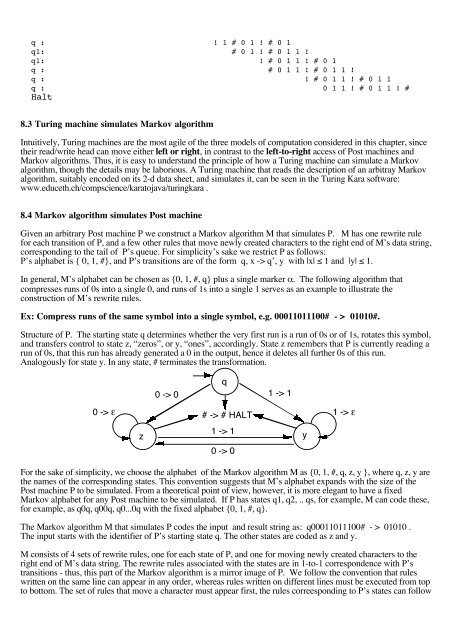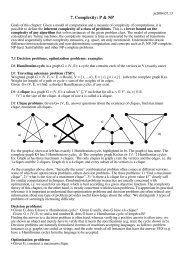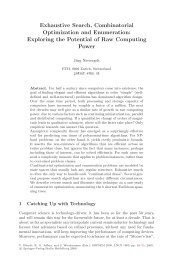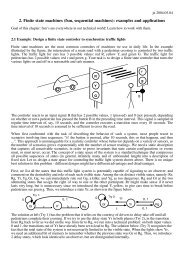8. Equivalence of TMs, PMs and Markov algorithms - Jn.inf.ethz.ch
8. Equivalence of TMs, PMs and Markov algorithms - Jn.inf.ethz.ch
8. Equivalence of TMs, PMs and Markov algorithms - Jn.inf.ethz.ch
Create successful ePaper yourself
Turn your PDF publications into a flip-book with our unique Google optimized e-Paper software.
q : ! 1 # 0 1 ! # 0 1q1: # 0 1 ! # 0 1 1 !q1: ! # 0 1 1 ! # 0 1q : # 0 1 1 ! # 0 1 1 !q : ! # 0 1 1 ! # 0 1 1q : 0 1 1 ! # 0 1 1 ! #Halt<strong>8.</strong>3 Turing ma<strong>ch</strong>ine simulates <strong>Markov</strong> algorithmIntuitively, Turing ma<strong>ch</strong>ines are the most agile <strong>of</strong> the three models <strong>of</strong> computation considered in this <strong>ch</strong>apter, sincetheir read/write head can move either left or right, in contrast to the left-to-right access <strong>of</strong> Post ma<strong>ch</strong>ines <strong>and</strong><strong>Markov</strong> <strong>algorithms</strong>. Thus, it is easy to underst<strong>and</strong> the principle <strong>of</strong> how a Turing ma<strong>ch</strong>ine can simulate a <strong>Markov</strong>algorithm, though the details may be laborious. A Turing ma<strong>ch</strong>ine that reads the description <strong>of</strong> an arbitray <strong>Markov</strong>algorithm, suitably encoded on its 2-d data sheet, <strong>and</strong> simulates it, can be seen in the Turing Kara s<strong>of</strong>tware:www.educeth.<strong>ch</strong>/compscience/karatojava/turingkara .<strong>8.</strong>4 <strong>Markov</strong> algorithm simulates Post ma<strong>ch</strong>ineGiven an arbitrary Post ma<strong>ch</strong>ine P we construct a <strong>Markov</strong> algorithm M that simulates P. M has one rewrite rulefor ea<strong>ch</strong> transition <strong>of</strong> P, <strong>and</strong> a few other rules that move newly created <strong>ch</strong>aracters to the right end <strong>of</strong> M’s data string,corresponding to the tail <strong>of</strong> P’s queue. For simplicity’s sake we restrict P as follows:P’s alphabet is { 0, 1, #}, <strong>and</strong> P’s transitions are <strong>of</strong> the form q, x -> q’, y with |x| ≤ 1 <strong>and</strong> |y| ≤ 1.In general, M’s alphabet can be <strong>ch</strong>osen as {0, 1, #, q} plus a single marker α. The following algorithm thatcompresses runs <strong>of</strong> 0s into a single 0, <strong>and</strong> runs <strong>of</strong> 1s into a single 1 serves as an example to illustrate theconstruction <strong>of</strong> M’s rewrite rules.Ex: Compress runs <strong>of</strong> the same symbol into a single symbol, e.g. 00011011100# - > 01010#.Structure <strong>of</strong> P. The starting state q determines whether the very first run is a run <strong>of</strong> 0s or <strong>of</strong> 1s, rotates this symbol,<strong>and</strong> transfers control to state z, “zeros”, or y, “ones”, accordingly. State z remembers that P is currently reading arun <strong>of</strong> 0s, that this run has already generated a 0 in the output, hence it deletes all further 0s <strong>of</strong> this run.Analogously for state y. In any state, # terminates the transformation.0 -> εzq0 -> 0 1 -> 1# -> # HALT1 -> 10 -> 0y1 -> εFor the sake <strong>of</strong> simplicity, we <strong>ch</strong>oose the alphabet <strong>of</strong> the <strong>Markov</strong> algorithm M as {0, 1, #, q, z, y }, where q, z, y arethe names <strong>of</strong> the corresponding states. This convention suggests that M’s alphabet exp<strong>and</strong>s with the size <strong>of</strong> thePost ma<strong>ch</strong>ine P to be simulated. From a theoretical point <strong>of</strong> view, however, it is more elegant to have a fixed<strong>Markov</strong> alphabet for any Post ma<strong>ch</strong>ine to be simulated. If P has states q1, q2, .. qs, for example, M can code these,for example, as q0q, q00q, q0...0q with the fixed alphabet {0, 1, #, q}.The <strong>Markov</strong> algorithm M that simulates P codes the input <strong>and</strong> result string as: q00011011100# - > 01010 .The input starts with the identifier <strong>of</strong> P’s starting state q. The other states are coded as z <strong>and</strong> y.M consists <strong>of</strong> 4 sets <strong>of</strong> rewrite rules, one for ea<strong>ch</strong> state <strong>of</strong> P, <strong>and</strong> one for moving newly created <strong>ch</strong>aracters to theright end <strong>of</strong> M’s data string. The rewrite rules associated with the states are in 1-to-1 correspondence with P’stransitions - thus, this part <strong>of</strong> the <strong>Markov</strong> algorithm is a mirror image <strong>of</strong> P. We follow the convention that ruleswritten on the same line can appear in any order, whereas rules written on different lines must be executed from topto bottom. The set <strong>of</strong> rules that move a <strong>ch</strong>aracter must appear first, the rules correesponding to P’s states can follow







![CV [PDF]](https://img.yumpu.com/5256601/1/184x260/cv-pdf.jpg?quality=85)